How to grow large bell peppers in a greenhouse: care rules
Obviously, in a greenhouse it is much easier to create optimal conditions for growing pepper, namely, to maintain the required temperature regime and the required humidity, because pepper is a very thermophilic culture that sharply reacts to sudden changes and changes in the microclimate.
Well, let's talk in more detail about how to properly care for pepper in a greenhouse, what are the main aspects of the cultivation of this crop.
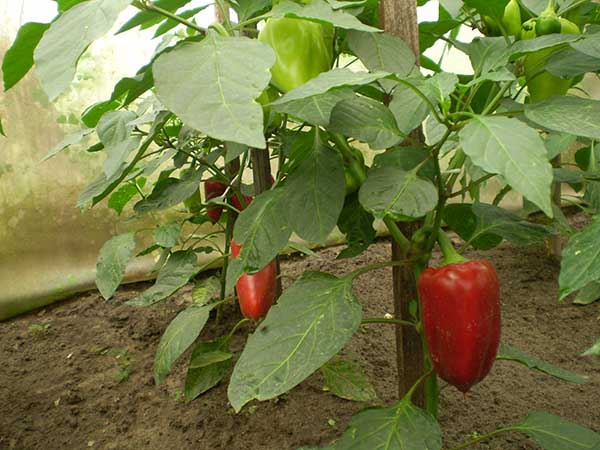
Content
When and how to plant pepper seedlings in a greenhouse
Pepper seedlings at the required age (50-60 days), of the appropriate size (20-25 cm in height) have 6-12 leaves.
The air is warm enough, the soil in the greenhouse has warmed up, the spring return frosts have passed.
Can pepper seedlings be planted in a greenhouse?
Advice! All information about the timing and rules for planting pepper seedlings in a greenhouse you can get by reading this detailed article.
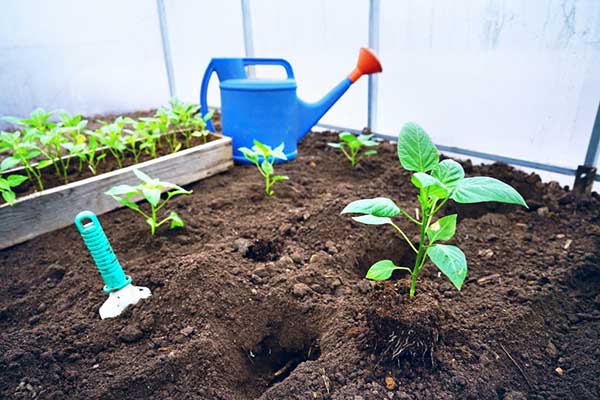
Growing sweet peppers in a greenhouse: basic rules for care and maintenance
Well, it's time to analyze all the basic agrotechnical aspects (techniques) of proper care for peppers in a greenhouse.
Growing conditions: light, temperature, humidity
Pepper is a culture that is not only thermophilic, but also, naturally, photophilous. Therefore, there must be enough light in the greenhouse. If the bell pepper bushes are shaded by other greenhouse plants, for example, cucumbers, then nothing good will come of it.
Also, bell peppers do not like sudden changes in temperature and excessively high humidity.
- The optimum temperature inside the greenhouse for the successful cultivation of peppers is +18 .. + 22 degrees at night (not lower than +15) and +22 .. + 27 during the day (not higher than +30 .. + 35);
- The ideal humidity is 60-75% (no higher than 80-85%).
In such conditions, the peppers will grow well, bear fruit well and not get sick.
Note! At temperatures below +15 degrees, the peppers stop growing, and above +30 .. + 35 they do not pollinate (the pollen becomes sterile), flowers and buds fall off.
One of the most important factors in the successful cultivation of peppers in a greenhouse (like any other greenhouse crop) is regular ventilation, especially when it is summer heat.
However, it is equally important to keep the greenhouse closed when it is cool.
Important! If you see that condensation has formed on the walls of the greenhouse (high humidity), open the vents and doors rather.
If it suddenly started cold snap (frost), then the greenhouse should be promptly put 5 liter water containers (water heats up quickly during the day and cools down for a long time at night) and shelter seedlings non-woven fabric or film.
Watering
Pepper is one of the most demanding vegetable crops for soil moisture. It is timely watering that will help you significantly increase the yield of this crop.
Interesting! Pepper suffers greatly from waterlogging, however, it is quite resistant to drought.
The frequency and amount of watering depends on the phase of pepper development (after planting and before flowering more often, less often during fruiting, but more abundant, because the larger the plant, the more moisture it needs), weather conditions (cool - less often, hot - more often ) and, of course, the soil itself, namely from its mechanical composition (sandy - more often, clay - less often).
Advice! The site already has detailed material about how to water pepper properly.
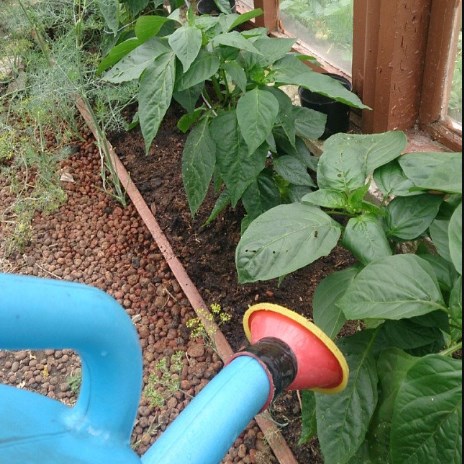
Loosening and weeding
Pepper is very sensitive to soil compaction and lack of air, therefore, after each watering, the soil must be loosened, as well as weed aisles from weeds.
By the way! If you do not want to water often, loosen and fight weeds, then just mulch the soil near the peppers with a layer of 5 cm.
Mulching
Mulching will help keep moisture in the soil longer, and you won't need to water your peppers as often (i.e. much less often).
But these are not all the benefits of soil mulching:
- Mulch prevents plants from overheating during the day in the heat and keeps the soil warm at night;
- does not allow weeds to grow;
- in addition, it accelerates biological processes in
soil and promotes better plant intake of nutrients (a layer of humus forms under the mulch as a result of the vital activity of soil microorganisms and worms).
As for whether is it possible to water directly on mulch, from abovethen the answer is Yes, can.
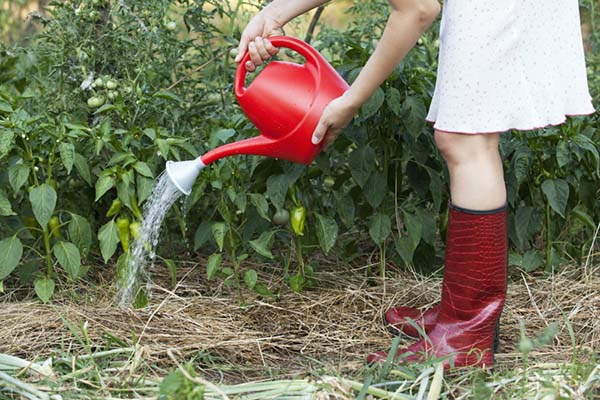
Than can mulch pepper:
- rotted manure (humus) or compost.
- sawdust;
- straw or hay;
- freshly cut grass.
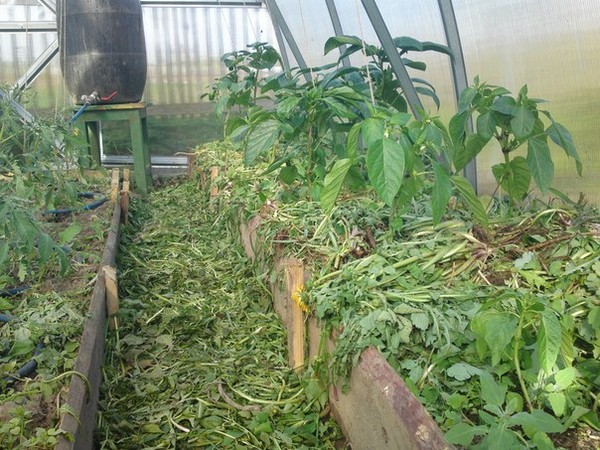
Top dressing
As a rule, for feeding peppers (like tomatoes) in the greenhouse, they adhere to the following scheme, focusing on the phases of its development:
Advice! The site already has a separate material about how to properly feed peppers in a greenhouse.
- after planting in the greenhouse and before flowering - more nitrogen;
- during flowering (if unfavorable weather - very hot) - boron;
At the same time, it will be very good if you give calcium fertilizing before and during fruit setting (spray on the leaves and ovaries).
- during fruiting - less nitrogen (but a little is still needed), more potassium (for example, ideally, potassium nitrate. You can simply combine top dressing, for example, potassium sulfate and urea, or use wood ash and herbal infusion, mullein or poultry infusion litter), a little phosphorus (one feeding will be enough liquid superphosphate solution).
Of course, you can use special fertilizers for peppers (tomatoes, and eggplants).
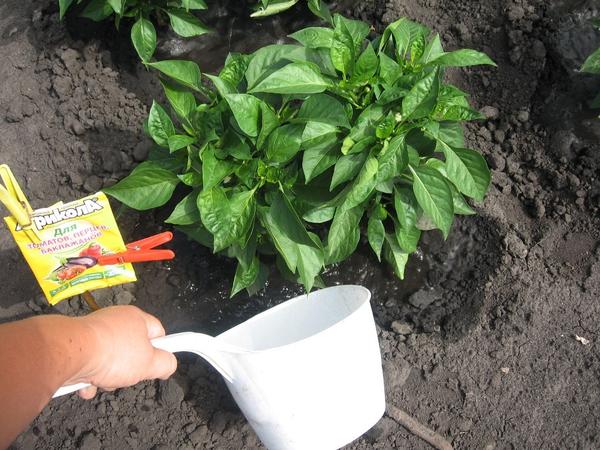
Important! EIf you have properly filled the soil with nutrients during the preparation of the beds for the peppers (or put it in the hole), then most likely you will not need any additional dressings (except for potash, they must be done during the fruiting period).
However, if the plant starts signaling that something is missing, then you have no choice: you need to fertilize (and preferably on the leaves so that the necessary nutrition immediately enters the plant).
All information about when and what to feed pepper is, in this material.
Garter
Obviously, even medium-sized plants need support so that they do not lie on the ground (where they can easily become infected with one of the fungal diseases) and do not break off their branches.
The easiest way is to tie each bush to an individual peg.
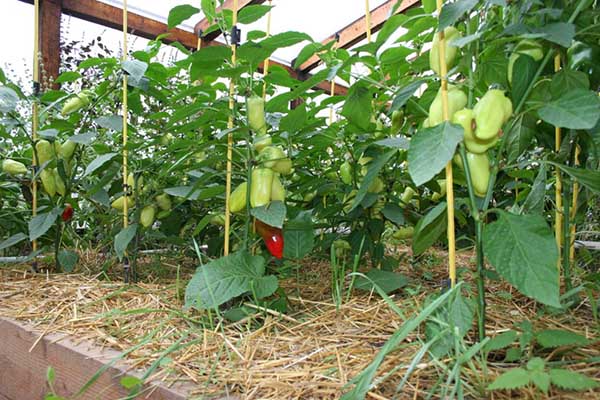
However, peppers, like tomatoes, are most conveniently tied to vertical trellises, i.e. fix the twine (twine) on the ceiling of the greenhouse.
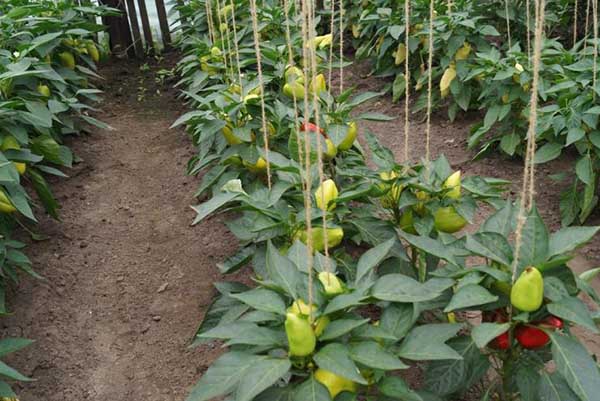
Alternatively, you can stretch 2-3 horizontal strings along the row and tie them to them, if it is more convenient for you.
Video: a convenient and quick way to garter peppers
Formation (pinching, crop normalization)
As a rule, after many fruits are set on a young plant, its vegetative growth will stop. However, the formation of a load on the plant can help to establish a more favorable balance between growth and fruiting (in the direction of increasing yields and accelerating ripening). So, for example, it is very desirable to remove the first flower in the center of the plant (it is also called "crown"). Such a procedure will especially strongly stimulate growth and bring the harvest time closer.
Thus, the formation of pepper consists in the removal of stepchildren (pinching), flowers, leaves, as well as pinching the shoots.
By the way! Low-growing, as well as weakly branching hybrids and varieties of pepper do not need to be formed.
How to form pepper in a greenhouse will be described in more detail in one of the following articles. In the meantime, you can look at the formation diagram and a video on the topic.
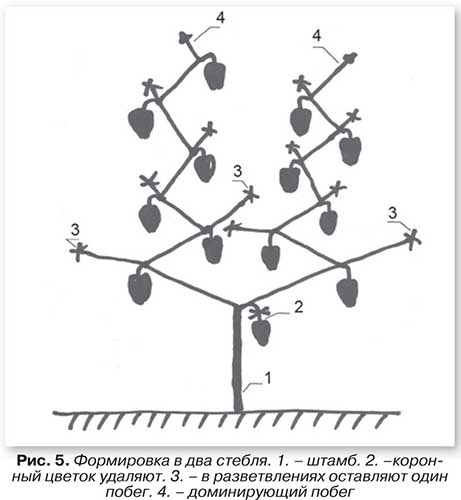
Video: Shapes Peppers for an Early Harvest
Diseases and pests of pepper: prevention and protection
Remember! It is always better to prevent than to cure (diseases) or fight directly (pests).
Accordingly, protective and preventive treatments (spraying) of pepper against diseases and pests should be carried out.
The most common diseases of pepper are late blight, various spots and rot, botrytis (gray rot), alternaria (black spot), fusarium and verticillary wilting, blackleg (relevant for the seedling period), downy mildew, viral diseases.
Worth knowing! Top rot of fruit Is not a disease, but a consequence calcium deficiency (or lack of moisture, as a result of which calcium is not absorbed).
So, for the prevention of pepper diseases it is useful to process the bushes with a solution Fitosporin, Gamaira, Alirina, Trichodermina (Trichoderma) and others biological fungicides (all apply according to the instructions).
It will be absolutely great if, when planting seedlings, you bury 1 tablet in the ground next to each bush Glyocladin (according to the instructions).
Greenhouse peppers can be attacked aphids, spider mites and whiteflies, as well as scoops and thrips. In short, the same set as for tomatoes.
In rare cases, juicy pepper leaves can be attacked by slugs.
Medvedka usually it does not climb into the greenhouse, but it is possible ...
For preventive treatments of peppers from pests, biological insecticides such as Fitoverm, Metarizine... Spray with a solution of green or tar soap, milk whey. And from the whitefly, you can additionally hang yellow sticky baits in the greenhouse.
By the way! The site has a number of articles on the fight against these pests, but on other crops (cucumbers and tomatoes):
When to harvest sweet peppers and how to store them
Required remove ripe fruits on time, giving the opportunity to develop to others (only emerging or ripening).
If the fruits hang on the bushes for too long, the yield of the pepper will decrease.
Fruit can be harvested as in technical (for storage) and biological ripeness (for eating or for processing) and generally required with stalk.
Important! The site already has an article about when and how to collect, and it is also better to store bell peppers in winter at home.
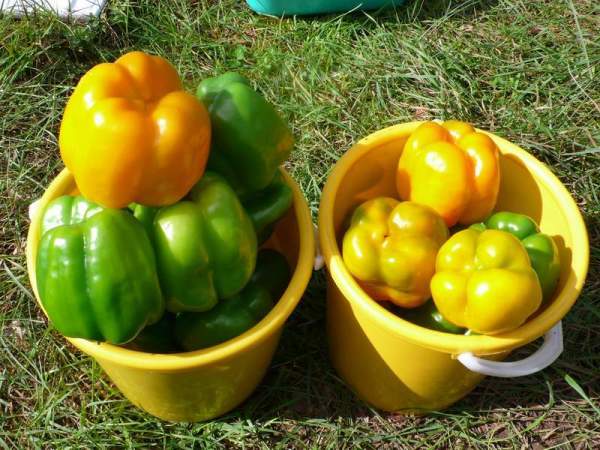
And after you harvest the last crop of peppers, you will need to clean the greenhouse from plant residues, rinse thoroughly and process it.
Advice! The site has a detailed article about how to process a greenhouse in the fall after harvest and prepare it for winter.
Self-harvesting of pepper seeds
If you have planted a variety (and not a hybrid), and you really like it, then you can collect and prepare seeds yourself.
By the way! About, how to properly harvest pepper seeds yourself, detailed in this material.
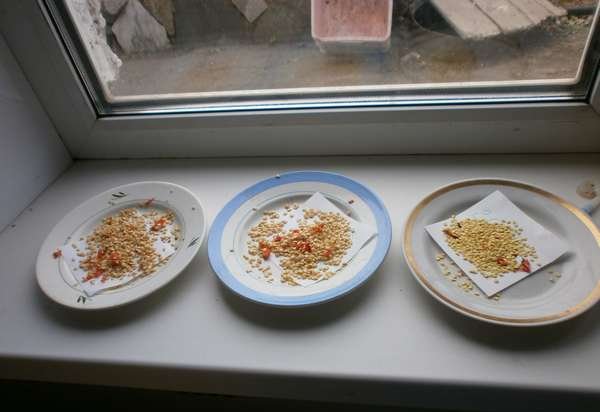
Well, now you know all the basic rules for growing and caring for peppers in a greenhouse. Put this advice into practice and you will definitely harvest an increased harvest of delicious and healthy peppers this year.
Video: rules for successfully growing peppers

